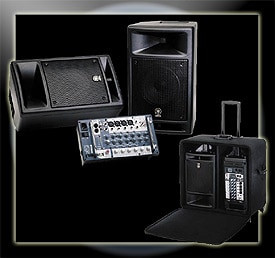Stagepas 300 (Singer & Musician, August 2005)
 |
In many ways, Yamaha's STAGEPAS 300 defies all conventional wisdom. It's not nearly large enough to sound as good as it does, the combination mixer=amp can't possibly be as compact as it is, and it must cost more than it does. But that's the age we live in. Every day, audio engineers and designers are figuring out ways to do what has been previously assumed undoable and the STAGEPAS 300 is a showcase of this out of-the-box thinking.
As much as I hate that cliché, this is one time it's just too appropriate. Once again with the conventional wisdom: "It takes more than two units to make a sound system." So ingrained is that thinking that even a veteran audio reviewer such as I thought, as I opened the box, "Something's missing." But what you see is not what you get. You may think they sent you only the loudspeakers, but turn them around. On the back of one speaker there's a diagram showing some typical configurations. Under the diagram is a useful space for storing a mic and maybe some cables. On the back of the other unit is what you were looking for: an eight-channel mixer with built-in amp loaded with tasty extras.
Hand Me That Flathead
Don't confuse the STAGEPAS 300 with another category of products known as powered speakers. Many powered speaker systems come with multiple inputs and some mixing capability, but this unit is different. First off, having a mixer on the back of the speaker is extraordinarily inconvenient-especially if you and your guitar or other instrument are center stage and your speakers are well out of arms' reach. This is not a problem with the STAGEPAS 300, simply grab your trusty Craftsman flathead (a dime will also work) and give the two slotted releases above the mixer a quarter turn. Out pops the little beauty, so you can place it on a music stand (or mic stand with optional adapter) and have it right where you want it.

Stagepas 300 |
On the outside, there are two 1/4" jacks to supply a signal to your left and right speakers. There are two additional line level outputs to feed powered speakers or an additional system. Stereo outputs are also provided for recording. There's a five-stage LED meter to monitor volume and limiter to save you from subjecting your loyal fans to distortion.
The layout of the mixer is quite nice. Considering it's footprint is just a tick over 6.5" x 11", there's a comfortable amount of finger room. For the performer who needs as few technical distractions as possible, little icons are provided as a guide to the correct channel. Lastly, two "roll bars" provide protection against busting a knob. There's very helpful interactive "mouse-over" diagram that explains all the features at Yamaha's Web site (www.yamaha.com).
Top to Bottom
The STAGEPAS 300 is rated at 100 watts at 6Ω per side. Distortion (THD) is shown at 1 percent for 100 watts and 10 percent at 150 watts (at 1kHz). While that may not sound the least bit impressive, the 150-watt output is a maximum number. The built-in limiter kicks in to chop the peaks and protect the speakers (and the audience) from any audible distortion. As a result, soft passages are louder, making the overall system louder. The downside would be a loss in dynamic range, but who cares? This isn't a hi-fi for the living room.
The STAGEPAS 300 is perfect for traveling singer-musicians who want the peace of mind of having their own system-one that they know and trust. There are enough inputs to handle guitar, vocals, and keyboard. We didn't try to use it as a bass amp, however, when assaulting it with the lowest notes on our Yamaha P-120 digital piano, played loud, distortion was minimal. For intimate venues, such as coffeehouses, small to medium church sanctuaries, lounges, and even isolated outdoor setups, this system can cut through. (You will most certainly want to upgrade before your first arena gig.) When you're not out gigging, the STAGEPAS 300 makes a more than adequate monitor system for practice, home recording, or listening to your own favorite CDs. (Hmm...makes a good hi-fi after all.)
 |
| © 2010 Yamaha Corporation of America. All rights reserved. |
